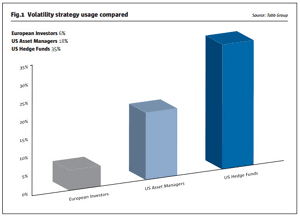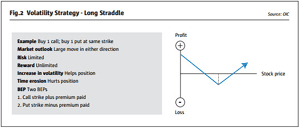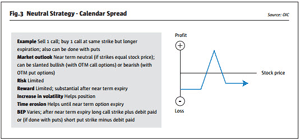One of the attractions of volatility trading is that the hedge fund manager can profit on a given index whether it goes up or down by using options, writes Stuart Fieldhouse of the Options Industry Council.
Volatility as an Asset Class
Volatility trading possesses a number of attractive qualities for both the fund manager and his ultimate investor. As an asset class, the cost of volatility increases when uncertainty increases, but also has a tendency to revert to a mean. It can be traded in a number of ways, including purely speculatively, or arbitraged (e.g., index vs. stock, or short-term vs. long-term, or implied vs. historical). But at the core of a successful volatility-based strategy lies the effective use of options.
As a hedge fund strategy, volatility trading has evolved significantly since the financial crisis, when many volatility specialist funds posted headline numbers. Since then investors have begun to see the volatility fund as more than just a hedge against volatile markets, but also as an investment in its own right. This has occurred as skilled fund managers have begun to demonstrate that they can go both long and short volatility.
The VIX index—the CBOE (Chicago Board Options Exchange) volatility index (VIX) (VXX)—has established itself as one of the key volatility benchmarks in the market and offers some excellent options trading opportunities, allowing the fund manager to go long or short vega (the option's level of sensitivity to changes in the volatility of an underlying asset). While the VIX contract is the volatility option flagship, other volatility indexes are gaining in popularity, including the CBOE Emerging Market ETF Volatility Index (VXEEM) and CBOE Gold Volatility Index (GVZ).
Implied volatility is part and parcel of the way options are priced. The fair price of an option will reflect not only the implied volatility, but also the market dynamics and the forces of supply and demand. This leaves it open to arbitrage strategies where the fund manager will compare the forecast volatility in the underlying instrument (e.g., an index) with the existing implied volatility of an option. With the accurate pricing of options under the Black-Scholes formula, this will require a degree of reliance on the manager's forecast for volatility, and analysis that can reveal mispricing situations that a shrewd manager can capitalize on.
Funds can also hedge implicit volatility exposure—risk arbitrageurs, for example, might be hoping to take advantage of narrower spreads in the stocks of companies planning to merge.
Using Options to Trade Volatility
Funds which specialize in volatility trading will often take advantage of unusually high implied volatility by selling both a slightly out-of-the-money call option and an out-of-the-money put option coupled with the purchase of both a call further out on the upside, and a put further out on the downside. This trade, commonly referred to as an iron condor, is one of the favored means of making money on implied volatility.
NEXT PAGE: Institutional Volatility Strategy Usage
|pagebreak|In the past, options contracts tended to be over-priced, partly because 99% of the market participants used to take a directional bias. Prior to today's technological trading enhancements, this created plentiful arbitrage opportunities as hedge funds took advantage of this available alpha. Some early volatility funds were simply long equity volatility trackers, a similar function to what a volatility index tracker might provide today.
Institutional Volatility Strategy Usage
Because listed options markets are highly liquid in broad market indices and US blue chips, volatility strategies can grow into multi-billion dollar portfolios. Successful funds in this area are those which can continue to evolve and capitalize on the changing nature of both underlying markets and the available opportunities in options markets.
Most hedge funds trading volatility remain focused on the equity or index volatility space, but volatility hedge funds are also able to effectively trade volatility over a number of different markets, including commodities and currencies. This expands their opportunity set and also cuts down on concentration risk. Volatility trading can be both a fundamental and a quantitative strategy, although the more successful funds are increasingly adopting more of a rules-based approach to the asset class.
One of the attractions of volatility trading, say on an index, is that the hedge fund manager can profit on a given index whether it goes up or down through the use of options. Delta hedging allows the fund manager to hedge away the linear component of a call option to produce a security with a curved P&L. For the trader with a long position, this can make money if the realized volatility exceeds the implied volatility with sufficient magnitude.
A delta-hedged option does not represent a pure, clean bet on volatility, as it tends to assume smooth stock movements, zero transaction costs, and relies upon known historical volatility. In reality, markets do not conform to a purist application of options pricing, particularly as the manager cannot hedge continuously and must also hedge discretely. Imperfections of this nature can undermine the gains, which the fund could make in theory. Hedging continuously, for example, will introduce additional transaction costs, which will impact the manager's expected return.
Black-Scholes requires that an index must have some expected level of future volatility to make an options price a fair one, but if the model were to be right, then all options would need to have the same implied volatility, which simply isn't the case. This makes hedging harder when trading volatility. Since 1987, volatility skews have been observed as persistent, linear and inconsistent with Black- Scholes. The so-called 'volatility smile' (variation in implied volatility with strike and expiration price of options) has been observable across a range of markets, including currencies.
NEXT PAGE: Favored Volatility-Based Strategies
|pagebreak|Favored Volatility-Based Strategies
The Straddle: A long straddle is achieved when buying both a call option and a put at the same strike price and expiration date. Because the positions are at-the-money, they provide the best time value and the greatest absolute volatility exposure. This is a short-term trade with the expectation of an immediate increase in volatility. They effectively double the exposure to volatility when compared with a single option purchase, but have significant time decay. (See Fig.2).
Long Straddle Chart
The Strangle: Less costly than the straddle, the strangle trade uses the same maturity for the two contracts, but different strike prices. The same off-set benefits are achieved, generally using out of the money options. This means a smaller premium compared to the straddle, with less time decay. Out-of-the-money options also experience the most impact in terms of percentage changes if there are sudden, drastic changes in implied volatility.
The two trades above are best used when the fund manager does not have an opinion on where the underlying market is going, but feels that volatility will increase over the short term, and certainly before time decay takes out the value of the position.
Selling Volatility: If options are being over-valued, an astute manager can sell volatility. Much depends on whether he can establish an accurate estimate of future volatility and use those options strategies, which will benefit from a fall in implied volatility. A short straddle trade is considered one of the purest approaches to this opportunity although a short strangle (sale of an out-of-the-money call and an out-of-the-money put) may also work. Selling volatility allows the fund manager to make money on both a decrease in volatility and time decay.
Long Call Butterfly Spread: This involves the sale of at-the-money options with the highest time value while buying both out-of and in-the-money options as disaster insurance. The low time value options are used to limit the loss risk on both the upside and downside of the trade. A net premium must be paid to establish the position. There are a number of different approaches to establishing a butterfly (e.g., a bull call spread coupled with a bear call spread). It is a short volatility trade, making money from decreasing volatility. It is often used by under-capitalized traders who wish to sell volatility but also protect against the potential unlimited loss in the straddle or strangle approach.
Calendar Spread: One option is sold and another bought at the same time, with the only variation being the month of expiry. The goal is to have the underlying price stay close to the short strike price heading into the expiry of the contracts. The premium of the sold, or nearer-term, option should decay faster than the bought, or further-out option. The bought option has a higher sensitivity to implied volatility, allowing the manager to make money if the implied volatility of the options rises. Calendar trades can be speculative (strike price of the spread is further away from current price, requiring a larger movement in favor before profits are realized) or income-based (decay of the option premium will go in the manager's favor). (See Fig.3).
NEXT PAGE: Risk Management
|pagebreak|Calendar Spread Chart
Risk Management
Markets are frequently unpredictable. Managers trading volatility as an asset class must be aware that they own both term volatility and specific strike-based volatility. In addition, the models they use will vary depending upon the underlying market. Currencies, for example, will tend to have stochastic volatilities, while interest rate volatilities will revolve around rate levels. It can also be extremely hard to test strategies effectively.
When trading options to capitalize on volatility, managers must also be sensitive to time decay. This can make it expensive to keep a given position active, and has proved costly in some instances where volatility has remained persistently low, sometimes unexpectedly so.
Discipline is required when using a spread-based strategy to capture volatility. The trade must be taken off as a spread rather than viewed as separate components . If volatility has been bought at a low level with the expectation that it will be higher in a few days, then the manager must be resistant to underlying market jolts and the temptation to close one side of the spread. Sellers of volatility must also be aware that, as with a conventional short trade, there is significant loss potential. This is a particular risk for a fund that becomes a habitual seller of volatility.
Pre-2007 volatility specialists were heavy users of OTC options, but since the financial crisis, many volatility hedge funds have cut down or eliminated their OTC exposure entirely. Most now focus on listed options and have done much to eliminate counterparty risk.
What Investors Think
Volatility funds first attracted investors because volatility represented an uncorrelated play.
It was obvious from an early stage that managers who could consistently trade volatility as an asset class would represent a good diversification benefit for a portfolio of hedge funds. As market volatility picks up, investors will also then focus on volatility funds in the expectation that this strategy will yield superior returns.
Investor knowledge about the diversity of available strategies remains limited with a tendency to bracket all volatility funds together under the same analytical umbrellas, although their sources of return can be quite diverse. There is increasing awareness of the need for volatility-based investments to be diversified across multiple markets and sectors.
The fact that volatility funds will tend to make more money during periods of higher volatility make these funds attractive as a portfolio hedge against losses in other strategies. The increased use of exchange- traded options contracts make the funds more transparent and easier to price, yet another boon from an investor perspective.
Conclusion
Traders of volatility as an asset class are not seeing volatility leaving the market entirely, even during periods when markets are relatively quiet. The base volatility—the lowest point to which the VIX will typically sink—is higher than it was pre-2008. Fundamental issues surrounding the global banking system, the Eurozone, and the US debt ceiling, along with a long period of deleveraging, means that opportunities for hedge funds in this space will continue. Investor interest will also remain high as a consequence.
By Stuart Fieldhouse of the Options Industry Council
























